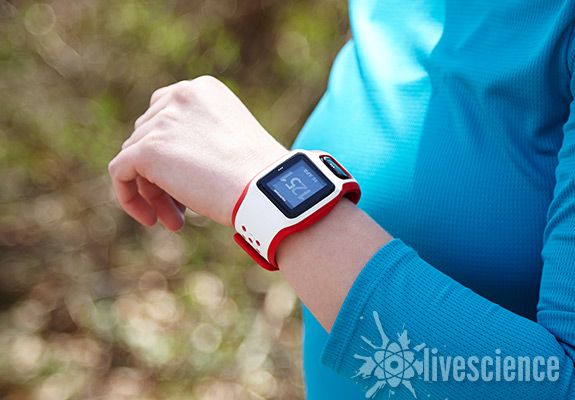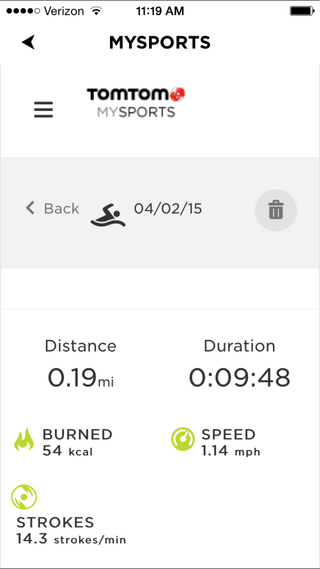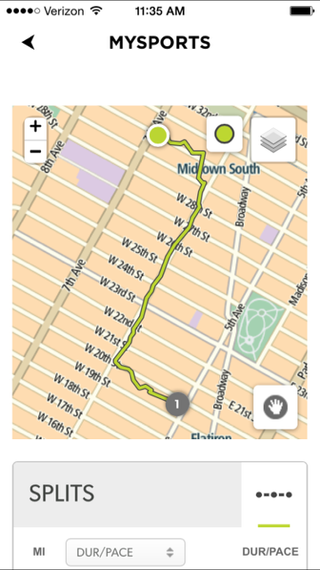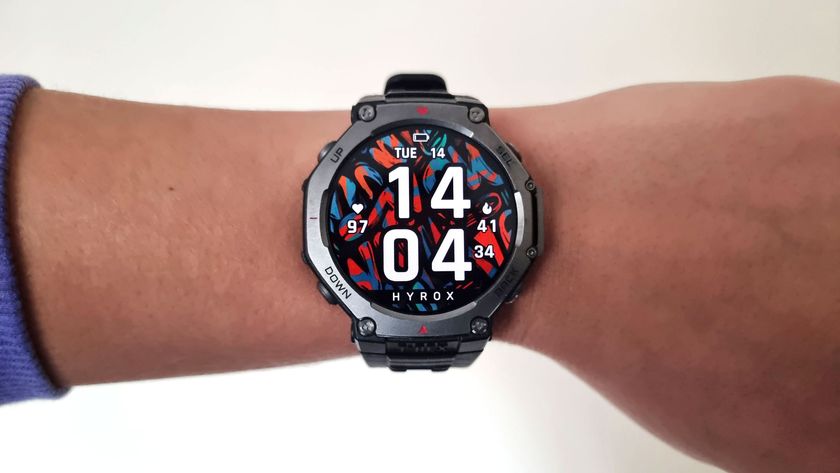TomTom Multi-Sport Cardio: GPS Watch Review

The TomTom Multi-Sport Cardio is a GPS watch that tracks running, indoor swimming and cycling. The watch has a built-in heart rate sensor that collects data about your pulse as you exercise. At $300, the TomTom Multi-Sport Cardio is one of the most affordable multisport GPS watches on the market. The Forerunner 920XT — a Garmin watch that also tracks running, swimming and cycling — retails for $490 with a compatible heart rate strap. I used the Multi-Sport Cardio for a month to track my runs, bike rides and swim workouts. Here's what I found: [Best GPS Running Watches]
Overall rating: 6.5/10
The Multi-Sport Cardio's built-in heart rate sensor sets it apart from other GPS watches in this category, all of which use external heart rate monitors that you strap around your chest. The watch's unique design (you can detach the display unit from the band without using any special tools) is also a practical feature for triathletes looking to mount the device on a bicycle.
However, the Multi-Sport Cardio cannot track open-water swims, and is unable to collect underwater heart rate data for swimmers. You also can't use this watch to track your steps or sleep, making it useless if you're looking for an everyday activity tracker. TomTom's app and website also lack the social networking features you'll find with multisport watches from companies like Garmin and Suunto.
Design/Comfort: 7/10
The Multi-Sport Cardio has a unique design that sets it apart from other GPS watches I've tested. The watch is made up of a display screen and, underneath the display, a large, four-sided button that you press up, down, left or right. The display screen and button can easily be removed from the plastic wristband, allowing you to slip the unit into a bike mount to track cycling. Other multisport watches can also be attached to bike mounts, but most require you to purchase a special kit (called a quick-release kit) that attaches to the back of the watch and lets you move the unit off your wrist and onto a bike in a hurry.
The review unit I tested was red and white, but the watch also comes in green and white, as well as red and black. None of these color options are very discreet or even particularly attractive. If you're looking for a multisport watch with a more subtle design, you might consider the Suunto Ambit3 Sport, which comes in a few refreshingly simple colors, like black and white.
Though I didn't love the Multi-Sport Cardio's color, I did like its size. At 0.8 inches (22 millimeters) wide, this watch's display is significantly smaller than that of the Garmin Forerunner 920XT, which measures about 2 inches (50 mm) wide. I had no trouble seeing this smaller screen as I ran or biked, and I could even see it very clearly underwater. Navigating the device was a bit tricky at first, but after spending some time with the watch, I came to appreciate the simplicity of its "one button" design.
Sign up for the Live Science daily newsletter now
Get the world’s most fascinating discoveries delivered straight to your inbox.

User friendliness: 7/10
Setting up the Multi-Sport Cardio is very straightforward. As with most GPS watches, you'll need to download the manufacturer's software onto your computer to get started. If you don't already have a TomTom account, you'll be prompted to sign up and log in to the company's MySports portal — the site where you can view the data that the watch collects. If you have a smartphone or tablet, you can also download the MySports mobile app to sync data from the watch wirelessly and check out your stats on the go. Without the app, you'll have to plug the Multi-Sport Cardio into your computer to sync data.
Both the mobile app and the MySports dashboard are simple to navigate, and you can view a list of your workouts in chronological order. You can click on a workout to analyze it and see more details, including a map, if you're looking at a GPS-enabled activity. I found the GPS maps that this watch created to be very accurate. And of all the GPS watches I've tested, the Multi-Sport Cardio was the most consistent at quickly acquiring a satellite lock. It even picked up a GPS signal quickly in midtown Manhattan, where tall buildings sometimes prove to be an obstacle for other watches.
Unlike the Forerunner 920XT, the Multi-Sport Cardio doesn't count steps or do any kind of analysis of your daily activity. In other words, this watch won't second as a basic fitness tracker. The Multi-Sport Cardio also doesn't do continuous heart rate monitoring. If you want a GPS watch that will keep track of your pulse all day long, you might want to look at the Fitbit Surge. This fitness tracker is not waterproof, but it does have an always-on, built-in heart rate sensor. [The Best Heart Rate Monitor Watches]
Since the TomTom's heart rate sensor was only enabled when I was working out, I found that its battery life was much better than other devices, like the Surge, that have this feature always on. You can use the Multi-Sport Cardio for up to 10 hours in GPS mode, but when both the heart rate sensor and the GPS are enabled, you'll only get 8 hours of battery life. I didn't test to see how long the watch would last when the heart rate sensor was turned on, but Ray Maker, author of the popular fitness gadget blog DC Rainmaker, found that the Multi-Sport Cardio tracked his pulse for 26 hours straight before the battery died.
Value of information: 6/10
The Multi-Sport Cardio tracks an abundance of running metrics, including time, distance, calories burned, pace, elevation, heart rate and strides per minute (cadence). But unlike Garmin's Forerunner 920XT, this watch won't tell you your ground contact time (how much time your foot is touching the ground) or your vertical oscillation (your movement up and down, or "bounce"). The watch tracks similar data for cyclists, though the main metric displayed on the watch during bike rides is speed, not pace.
All of the data that the watch collects is displayed in an easy-to-read format within the app and MySports online dashboard. You'll see averages displayed prominently alongside a map of your route. Beneath the map, there's a graph that shows the changes in your speed, elevation or heart rate over the course of a workout. You can also click on the heart rate icon to see your heart rate "zones." I liked this feature because it helped me determine how fast I should run to keep my heart rate in the target zone for building endurance (something I'm trying to work on). If you're unfamiliar with heart rate training, the American Heart Association provides a useful explainer on its website.

In the pool:
Unfortunately, you can't use the Multi-Sport Cardio's heart rate monitor underwater. If you're looking for a watch with that capability, check out the Suunto Ambit3 Sport or the Polar V800, both of which are equipped to collect heart rate data in the water. These watches also have an open-water swimming mode that lets you collect GPS data when swimming in the ocean or another body of water. This is another feature the Multi-Sport Cardio is missing.
But TomTom's watch does track key swimming metrics, such as distance (in laps and miles or kilometers), strokes per lap and swimming efficiency (SWOLF). I tested the watch during several swims and found that it was both easy to read underwater and did a good job of counting my laps. [Best Fitness Trackers for Swimmers]
Enjoyment/Inspiration: 6/10
Overall, using the Multi-Sport Cardio was a no-nonsense experience. The other multisport GPS watches I tested have extra features that make using the watches more fun. For example, the Forerunner 920XT sends you "badges" when you accomplish your fitness goals. The Movescount app that accompanies the Suunto Ambit3 Sport has an interactive map that helps you connect with other athletes in your area. These aren't features that make or break a product, but I did miss them when they weren't available.
The impression I got from the Multi-Sport Cardio is that it tracks your runs, bike rides and swims without any frills or extra bells and whistles. And that makes sense, considering TomTom's watch is priced at $270, on the lower end for multisport GPS watches. The other devices in this category have an average retail price of $446. So, if inspiration is what you're looking for from your multisport GPS watch, prepare to pay a premium.
Follow Elizabeth Palermo @techEpalermo. Follow Live Science @livescience, Facebook & Google+.

Elizabeth is a former Live Science associate editor and current director of audience development at the Chamber of Commerce. She graduated with a bachelor of arts degree from George Washington University. Elizabeth has traveled throughout the Americas, studying political systems and indigenous cultures and teaching English to students of all ages.











